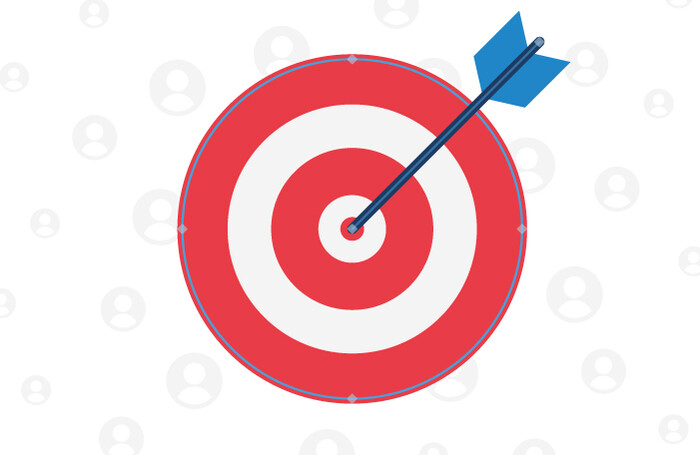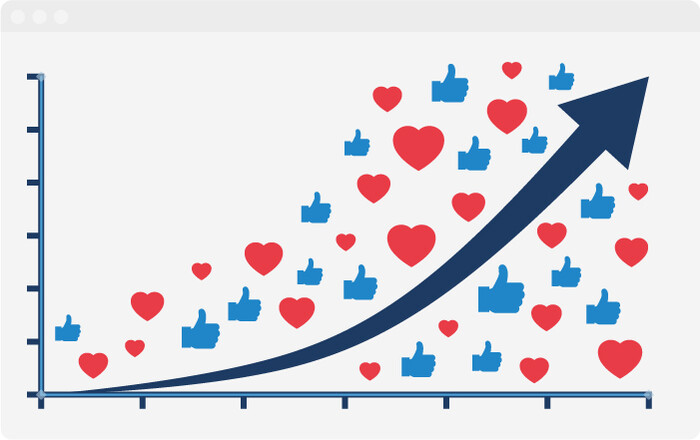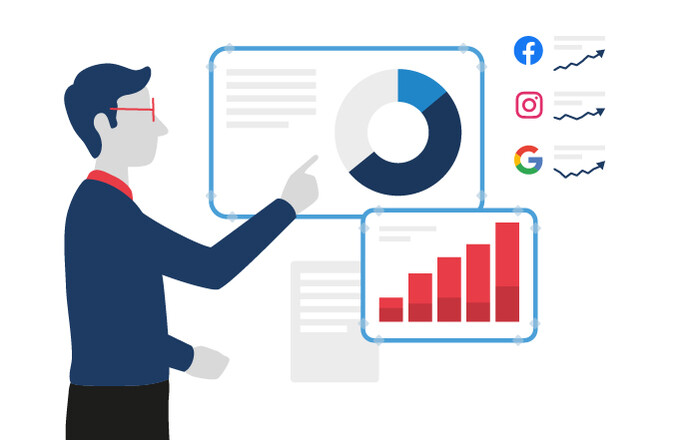17 reasons why you should advertise on Facebook, Instagram & Google
By now, most business leaders understand that a website and social media presence is a minimum requirement for digital marketing.
That said, marketers and agencies often meet resistance from up-top when recommending paid digital advertising platforms like Facebook, Instagram and Google.
Though SEO and organic social media require a time commitment, you don’t pay for impressions or clicks.
Essentially, they’re seen as “free”.
Why pay for Google and Facebook ads when there are “free” alternatives, right?
But, truth is, paid digital advertising is an extremely effective channel for driving business growth.
So it shouldn’t be overlooked.
It’s no accident that many high-growth businesses use paid digital advertising to help them scale.
It’s one of the best tools in a modern marketer’s arsenal.
To help show you just how valuable it is, here are 17 reasons why you should advertise on Facebook, Instagram and Google.
1) Rapid split-testing
Split-testing is the process of showing your audience multiple variations of an ad to determine which is most effective.
And, thanks to real-time data feeds, the process is rapid on digital channels like Facebook and Instagram.
Using this data, you can quickly establish a winning ad variation and pause less effective ad variations to earn maximum value from your ad spend.
2) Optimise on the fly
With traditional advertising methods like TV and billboard advertising it’s vital you nail an ad first time.
If you don’t, you risk losing A LOT of money.
With digital advertising, you can tweak ad creative elements, ad placements and audiences as your campaign runs.
If something’s not working, it’s easy to diagnose and cheap to fix.
3) Remove guesswork
Even today, some marketers and agencies are guilty of making too many assumptions about their audiences.
While educated assumptions have their place in marketing, we should validate our assumptions with data.
Incorrectly assuming 18-25 year old men will be most receptive to your products, for instance, could lead to poor product positioning and lost sales if they’re not.
Fortunately, Facebook and Google provide mountains of data to test your hypotheses against.
Using this data to your advantage can eliminate any potentially costly guesswork.

4) Advanced audience targeting
There’s another HUGE benefit to using all of that data mentioned above.
It allows you to precisely pinpoint very specific, niche audiences using numerous user behaviour and interest-based parameters.
As an example, if you wanted to target 50-60 year old women with an interest in sewing, you could.
This is particularly advantageous for small to medium-sized businesses that appeal to niche audiences.
5) Discover profitable new audiences
Lookalike audience building tools are one of, if not the, most powerful digital marketing tools.
Most digital advertising platforms – including Facebook, Instagram and Google – have one.
Though they’re built using complex machine-learning algorithms, the concept is straightforward.
They collect data on people who’ve interacted with your website and then use that data to create new audiences of similar users based on behaviour profiles.
Whether you think that’s kind of cool or kind of scary, one thing’s for sure – the resulting “lookalike” audiences are extremely effective.
6) Inexpensive to get started
Getting up and running on Facebook or Google is relatively inexpensive.
Though it wouldn’t stretch far, you could theoretically start with just £1 a day.
This is a stark contrast to traditional advertising channels like TV and print, which often demand hefty upfront costs.
This brings us neatly on to point 7…
7) No upfront costs
Although we’d recommend you pay a pro to set up your digital advertising, you don’t need to pay any “media spend” upfront.
With Google Ads and other search platforms, you tend to pay per click.
With social platforms like Facebook and Instagram, you usually pay per 1,000 impressions.
So, if no one clicks your Google ad, you don’t pay a penny.
Likewise, you won’t pay if nobody sees your ad on Facebook or Instagram.
A super valuable feature for those who don’t have access to chunky marketing budgets.

8) Easy to scale
Since they’re inexpensive to set up and don’t require upfront fees, digital ad platforms are easy to scale.
This makes them perfect for businesses looking for fast growth.
As an example, you could begin with a modest ad spend of around £500 per month.
Once you’re delivering a solid return, you can then increase your budget to unlock additional £’s.
Rinse and repeat the process as and when your business is ready to handle the next sales milestone.
9) Unreal ROAS
Markets are too volatile for us to promise an exact return on ad spend (ROAS).
That said, we’ve seen astronomical returns as high as 10:1.
That’s a £10 return for every £1 spent on digital advertising.
But, even though that 10:1 ROAS is less common, the average is somewhere around 3:1.
That’s still a cool £3 return for every £1 spent.
Imagine finding a savings account delivering a 200% interest rate, you’d want to put some money into it, right?
Well, that’s essentially what you get with a 3:1 ROAS.
10) Real-time customer insights
Customer insights are worth their weight in gold.
They provide creative inspo for campaigns and uncover new business development opportunities.
With Facebook Ads, you have access to these types of insight in real-time via the comments section.
If consumers are unhappy with your products, they’ll let you know and you can use this info to improve your service.
They’ll also let you know if there are new features or services they want to see which is great for business development.
Of course, you shouldn’t only pay attention to the negatives.
You can also use positive comments about your products as inspo for your marketing copy.
11) Personalised advertising
It’s unlikely that all your customers are motivated to use your products for the same reasons.
Let’s say you sell watches, for example.
Some users might want your watch as a status symbol, others as a fashion accessory and others because it’s practical and durable.
With Facebook and Google, you can create lists of users based on these types of purchase motivation.
You can then deliver personalised advertising messaging to each different user segment.
So, you might show your fashion accessory segment an ad highlighting the range of coloured wrist straps you offer.
Or, you could also show your practical shopper segment an ad about your shatter-proof watch face.
When you personalise ads like this, you massively increase the odds of winning the conversion.
12) Reach users where they spend most of their time
Users spend an average of 2 and half hours per day on social media.
On top of that, it’s thought the average person completes 3–4 Google searches a day.
With this considered, there’s a high chance you’ll find your target audience on either social or Google.
Most likely both.
As such there’s no downside to investing in either Facebook or Google Ads.
Doing so is a surefire way to connect with your audience.
13) Retargeting
Retargeting is an advertising strategy where you show custom advertising to users who’ve already interacted with your business.
And, like creating lookalike audiences, it’s one of the most effective digital marketing strategies you can use.
It’s thought to boost conversion rates by as much as 147%.
Not too shabby.
Google’s (soon-to-be-discontinued) cookie and Facebook’s pixel, make retargeting a breeze.
But they’re only available on their paid advertising platforms. So, you’ll need to invest in them if you want the benefits.
14) Faster route to success
As mentioned in the intro, optimising your website for search and building an organic social media presence takes time.
Even if you have a massive marketing budget, there’s no way to skip the queue and buy your way to the top of organic search.
It’s just not how it works.
That’s why Facebook and Google Ads are so useful.
You can pay to gain instant visibility on search and social channels and improve all-important brand awareness faster.
You’ll also drive a few extra sales and enquiries – always a welcome bonus.
15) Dynamic ads
In a nutshell, dynamic ads display different variations of an ad to users to increase the odds they’ll click or convert.
As an example, Facebook allows you to load up to 5 headline, body copy and description variations into an ad.
Users’ are then displayed a unique combination of these creative elements based on the likelihood they’ll respond positively to the ad.
Google Ads has a similar feature in responsive ads.
While there are no concrete stats about their effectiveness, in our experience dynamic ads almost always outperform static digital ads in driving engagement, clicks and sales.

16) Forecasting
As mentioned previously, we can never offer 100% accuracy when forecasting in digital. There are just too many variables.
However, both Facebook and Google have used their data to create reasonably accurate forecasting tools.
The platforms will analyse a range of metrics, including your available budget, and offer a prediction of how well a search or social campaign might perform over a given timeframe.
This is incredibly useful when you need to win buy-in from senior leaders.
And, though these tools aren’t infallible, they usually provide a solid ballpark estimate.
Of course, it feels good to outperform the forecast, so that’s always the aim!
17) It pays to pay
Both Google and Facebook make the bulk of their revenue from advertising.
As such, both platforms are built to favour those who pay for advertising.
After all, they want brands to keep paying for advertising since that’s what keeps the lights on.
One trend we’ve noticed, for instance, is that organic visibility has significantly dropped for many brands.
While they may have millions of followers, only a fraction of those followers see their posts regularly.
Why give you tonnes of visibility for free, when they can have you pay for it, right?
As such, to truly make the most of social and search channels, it pays to pay for advertising.
Wrap up
Alongside costs, there’s another common objection we get from brands about paid digital advertising:
“We’ve tried it before and it didn’t work!”
While this may be true, there’s usually an underlying reason that you haven’t been able to make either Facebook or Google Ads work for you.
First, it’s simply that you don’t know enough about how the platforms work.
You wouldn’t say a guitar was broken because you didn’t know how to play it.
Similarly, an ads platform isn’t wrong for your business just because you haven’t figured out how to optimise it yet.
Second, lower budgets can also be a hindrance.
While we can usually make lower budgets work, it takes more time.
These platforms are at their best when you’re feeding them lots of data. And, a bigger budget helps you acquire that necessary data faster.
So, if Facebook and Google Ads haven’t worked for you before, we’d still strongly urge you to reconsider.
In the right hands, they really can work like magic.
For more info on digital marketing–including paid advertising–make sure to check out our other blogs.
And, if you’d like to enlist the help of experts to help you grow your business through Facebook and Google ads, feel free to get in touch.